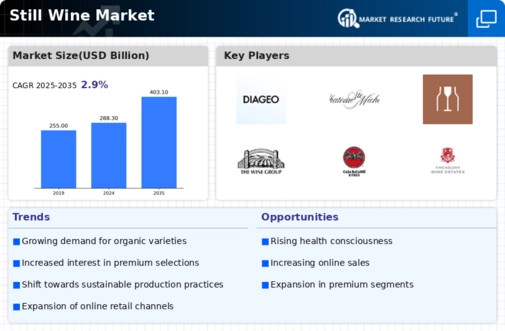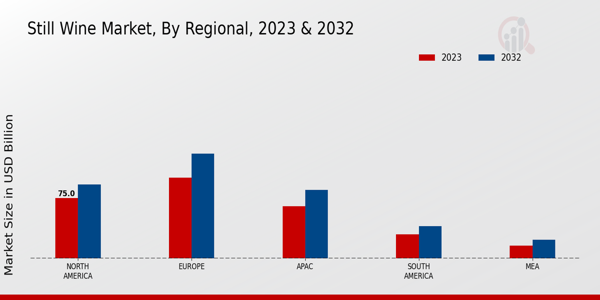Expansion of Wine Tourism
Wine tourism plays a pivotal role in the Global Still Wine Market Industry, as it encourages consumers to explore wine regions and engage with local producers. This sector's growth not only boosts local economies but also fosters a deeper connection between consumers and wine. Regions known for their vineyards, such as Napa Valley and Bordeaux, attract millions of visitors annually, contributing to the market's expansion. The increasing popularity of wine tourism is likely to enhance brand loyalty and stimulate sales, further driving the market's growth.
Market Growth Projections
The Global Still Wine Market Industry is projected to experience steady growth, with a market value expected to reach 403.1 USD Billion by 2035, reflecting a compound annual growth rate (CAGR) of 3.1% from 2025 to 2035. This growth trajectory indicates a robust demand for still wines across various regions, driven by factors such as changing consumer preferences and increased production capabilities. The anticipated growth presents opportunities for producers to expand their offerings and tap into emerging markets, further solidifying the industry's position on a global scale.
Innovative Marketing Strategies
Innovative marketing strategies significantly influence the Global Still Wine Market Industry, as producers leverage digital platforms and social media to reach a broader audience. Engaging storytelling and targeted advertising campaigns allow brands to connect with consumers on a personal level. For instance, virtual tastings and interactive content have become popular, especially among younger demographics. These strategies not only enhance brand visibility but also foster community engagement, which is essential for sustaining growth in a competitive market. As the industry evolves, effective marketing will remain crucial for capturing consumer interest.
Rising Consumer Demand for Premium Wines
The Global Still Wine Market Industry experiences a notable increase in consumer demand for premium wines, driven by a growing appreciation for quality over quantity. As consumers become more discerning, they seek wines that offer unique flavors and origins. This trend is reflected in the market's projected value of 288.3 USD Billion in 2024, with expectations to reach 403.1 USD Billion by 2035. The shift towards premium products suggests that consumers are willing to invest more in their wine choices, thereby enhancing the overall market landscape.
Sustainability Trends in Wine Production
Sustainability trends are increasingly shaping the Global Still Wine Market Industry, as consumers become more environmentally conscious. Wineries are adopting sustainable practices, such as organic farming and eco-friendly packaging, to appeal to this demographic. The commitment to sustainability not only enhances brand reputation but also aligns with the values of a growing segment of consumers. As the market evolves, the emphasis on sustainable practices is likely to drive innovation and attract environmentally aware consumers, thereby contributing to the industry's growth.
Health Consciousness and Wine Consumption
The Global Still Wine Market Industry is witnessing a shift in consumer preferences towards healthier lifestyle choices, which includes moderate wine consumption. Studies indicate that moderate wine consumption may offer certain health benefits, such as improved cardiovascular health. This trend aligns with the growing awareness of health and wellness among consumers, potentially leading to increased sales in the still wine segment. As the market adapts to these changing preferences, producers may focus on creating lower-alcohol and organic options to cater to health-conscious consumers.





















Leave a Comment